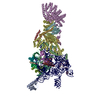+Search query
-Structure paper
| Title | Selected humanization of yeast U1 snRNP leads to global suppression of pre-mRNA splicing and mitochondrial dysfunction in the budding yeast. |
|---|---|
| Journal, issue, pages | RNA, Year 2024 |
| Publish date | Apr 30, 2024 |
 Authors Authors | Subbaiah Chalivendra / Shasha Shi / Xueni Li / Zhiling Kuang / Joseph Giovinazzo / Lingdi Zhang / John Rossi / Jingxin Wang / Anthony Saviola / Robb Welty / Shiheng Liu / Katherine Vaeth / Z Hong Zhou / Kirk Hansen / J Matthew Taliaferro / Rui Zhao /  |
| PubMed Abstract | The recognition of 5' splice site (5' ss) is one of the earliest steps of pre-mRNA splicing. To better understand the mechanism and regulation of 5' ss recognition, we selectively humanized ...The recognition of 5' splice site (5' ss) is one of the earliest steps of pre-mRNA splicing. To better understand the mechanism and regulation of 5' ss recognition, we selectively humanized components of the yeast U1 snRNP to reveal the function of these components in 5' ss recognition and splicing. We targeted U1C and Luc7, two proteins that interact with and stabilize the yeast U1 (yU1) snRNA and the 5' ss RNA duplex. We replaced the Zinc-Finger (ZnF) domain of yU1C with its human counterpart, which resulted in a cold-sensitive growth phenotype and moderate splicing defects. We next added an auxin-inducible degron to yLuc7 protein (to mimic the lack of Luc7Ls in human U1 snRNP) and found that Luc7-depleted yU1 snRNP resulted in the concomitant loss of PRP40 and Snu71 (two other essential yeast U1 snRNP proteins), and further biochemical analyses suggest a model of how these three proteins interact with each other in the U1 snRNP. The loss of these proteins resulted in a significant growth retardation accompanied by a global suppression of pre-mRNA splicing. The splicing suppression led to mitochondrial dysfunction as revealed by a release of Fe2+ into the growth medium and an induction of mitochondrial reactive oxygen species. Together, these observations indicate that the human U1C ZnF can substitute that of yeast, Luc7 is essential for the incorporation of the Luc7-Prp40-Snu71 trimer into yeast U1 snRNP, and splicing plays a major role in the regulation of mitochondrial function in yeast. |
 External links External links |  RNA / RNA /  PubMed:38688558 PubMed:38688558 |
| Methods | EM (single particle) |
| Resolution | 3.49 Å |
| Structure data | EMDB-43753, PDB-8w2o: |
| Source |
|
 Keywords Keywords |  SPLICING / U1snRNP / U1C humanization SPLICING / U1snRNP / U1C humanization |
 Movie
Movie Controller
Controller Structure viewers
Structure viewers About Yorodumi Papers
About Yorodumi Papers






